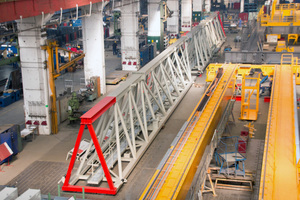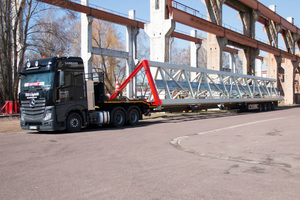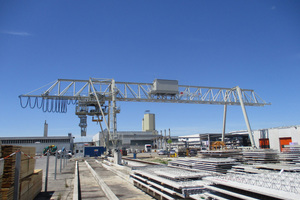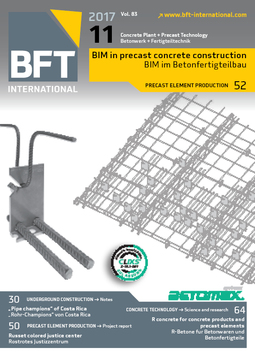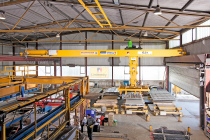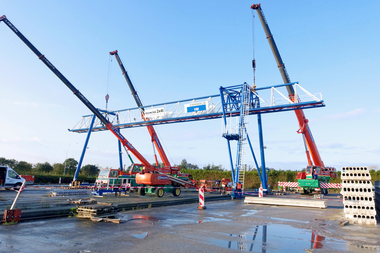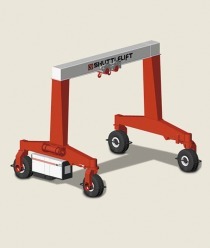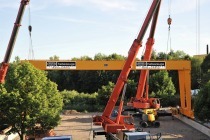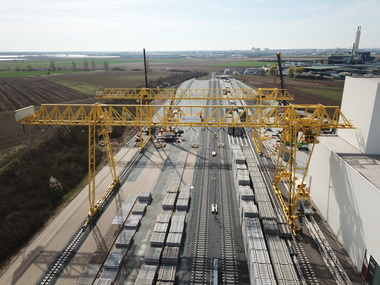New gantry crane for handling of concrete elements
Only ten months after awarding a contract, the new lattice gantry crane is already operating at the storage area of company Kemmler. The crane supplier Kranbau Köthen developed a customized crane product in trustful cooperation allowing the company based in Tübingen to manufacture in a highly flexible way, while improving the business and added-value processes.
A replacement purchase became necessary because the previous crane had reached the end of service life. The main task of the new crane is the handling of prestressed concrete slabs by means of a special gripper as lifting equipment.
An investment for the future
If existing crane systems have been in operation for quite a long time, the critical components reach the end of their service life eventually. Then, the purchase of a new crane system with a higher degree of specialization is an important step towards the future. That‘s just what the management of Kemmler had in mind in order to deal with new or changing market conditions and higher production requirements.
With Kranbau Köthen they found the suitable partner who met the particular requirements imposed on a new crane; this was proven by the numerous references of the company with a workforce of about 200 people working on 24,000 m² of roofed production floor.
Apart from the high technological requirements on the gripper, the fixed elevating and lowering cabin with scissor lift system providing for the stabilization and safety hoist is the highlight of the crane. It enables the crane operator to stay at eye level with the product; access is at ground level.
Technical data of the crane
The gantry crane designed as a lattice framework bridge is 17 m high and is equipped with a slewing trolley allowing changing the direction of the concrete elements from lengthwise to crosswise transport. In addition, the trolley is furnished with two hoists: each hoist has a nominal lifting capacity of 12.5 tons and can be used in single or in synchronous operation. Thus, the crane bridge has an overall lifting capacity of 25 tons and still 2 x 9.3 tons at the cantilever jibs. The usable cantilevers are 9.8 m long on the side of the fixed support and 9 m on the side of the pin-ended support. The track width of the crane amounts to 32.5 m; the length of the bridge girder is measuring 62.5 m.
The crane is primarily operating with a gripper. In this process, the building components can be lifted at a speed of up to 16 m/min depending on the load. The trolley travels with a speed of up to 80 m/min, gantry travels are possible at up to 90 m/min without any problems.
Electrical equipment of the crane
The crane is supplied by means of a cable reel. A fail-safe PLC with Profibus DP interface is used as control unit. State-of-the-art frequency converters are used as power electronics for hoist, crane and trolley drive systems. All drives are equipped with a speed feedback device to ensure precise control. A towing unit is used as power supply of the trolley. The switch gear is situated in the electrical house at the side of the bridge girder.
Operating panels provide for the visualization of the crane system; they are connected to the PLC as users via the Profibus. Highly efficient touch panels with color display are used for this purpose. There is one touch panel each in the cabin and the electrical house. It displays current operating data such as the lifting height, load and trolley position, but also possible failures. A modem linked to the PLC provides furthermore the possibility for remote diagnostics.
In-house production
For the production of their products, the crane supplier Kranbau Köthen relies on components in well-proven quality from the company‘s own shop floor. All production facilities needed in the manufacturing process are available.
The entire steelwork and various machine components are manufactured in Köthen by internal qualified personnel. The steel structures are conserved with the aid of an up-to-date coating system that is adapted to the ambient conditions.
However, the transportation of the crane caused them quite a headache and was particularly challenging. At a distance of more than 550 km between Köthen and Tübingen covered by several heavy goods transports they had to deal with or drive around obstacles such as bridges, road construction sites or railroad tracks. The subsequent entire assembly and commissioning of the gantry crane took place in a very short time so as not to interfere the ongoing handling processes.

